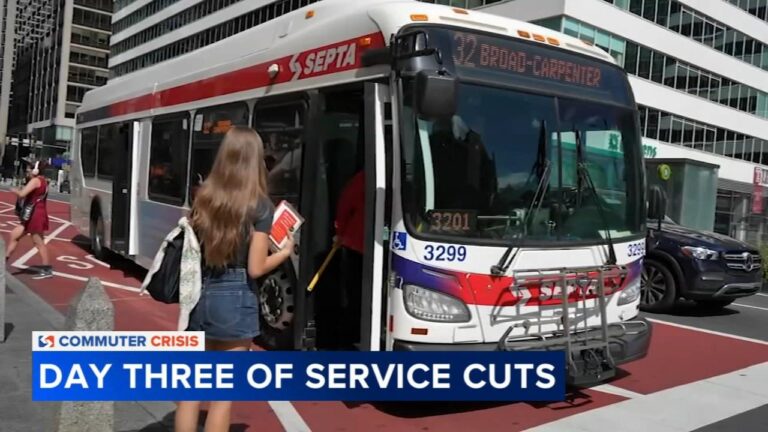Philadelphia Faces Major Transit Service Cuts Amid State Budget Crisis
Philadelphia’s public transportation network has recently undergone substantial service reductions, impacting thousands of commuters who depend on buses and trains daily. These cutbacks stem from a prolonged budget deadlock in Harrisburg, which has stalled vital funding for the Southeastern Pennsylvania Transportation Authority (SEPTA). As a result, many routes have been curtailed, and schedules compressed, leading to longer wait times and overcrowded vehicles, complicating travel for residents across the city.
Notable service changes affecting riders include:
- Decreased bus frequency during rush hours, especially in neighborhoods like West and South Philadelphia.
- Reduced weekend transit options, limiting mobility for weekend workers and leisure travelers.
- Temporary suspension of several underutilized rail lines to concentrate resources on primary transit corridors.
| Route | Previous Interval (minutes) | Current Interval (minutes) | Remarks |
|---|---|---|---|
| Bus 17 | 10 | 20 | Reduced frequency during peak periods |
| Broad Street Line South | 5 | 7 | Shortened trains, decreased capacity |
| Bus 57 | 15 | Service suspended | Indefinite route suspension |
State Budget Deadlock Jeopardizes Transit Funding and Service Quality
The ongoing stalemate over Pennsylvania’s state budget has placed Philadelphia’s public transit system under severe financial strain. SEPTA and other transit agencies face dwindling resources, forcing immediate service reductions that disrupt the daily routines of countless commuters. The suspension of multiple bus routes and diminished service frequency on key lines threaten not only rider convenience but also the economic health of neighborhoods reliant on dependable transit access.
Officials warn that if the budget impasse persists, further cuts could degrade service quality and accessibility citywide. The shrinking operational budget compels transit authorities to focus on essential routes, often at the expense of broader community connectivity. Concerns raised by stakeholders include:
- Longer wait times and overcrowding during peak travel hours
- Reduced transit access for low-income, elderly, and disabled populations
- Potential layoffs among transit employees due to funding shortfalls
- Increased traffic congestion and pollution as fewer commuters use public transit
Projected Budget Deficits and Service Impacts
| Funding Gap | Number of Routes Affected | Estimated Service Reduction | Anticipated Ridership Decline |
|---|---|---|---|
| $50 million | 12 | 25% | 15,000 riders/day |
| $75 million | 20 | 40% | 30,000 riders/day |
| $100 million | 30+ | 60% | 50,000 riders/day |
Calls for Legislative Intervention to Revive Essential Transit Services
Community advocates and local leaders in Philadelphia are uniting to oppose the recent transit service reductions, highlighting the disproportionate effects on vulnerable groups who rely heavily on public transportation. City council members, neighborhood organizations, and activists emphasize that these cuts hinder access to employment, healthcare, and education, particularly for low-income residents, seniors, and frontline workers.
In response to growing public concern, state lawmakers are reviewing proposals aimed at restoring transit funding and preventing further service degradation. Advocacy groups have outlined several critical priorities:
- Reinstating weekend and evening transit routes to improve accessibility
- Boosting subsidies to keep fares affordable for all riders
- Investing in infrastructure improvements to enhance service reliability and safety
| Stakeholder | Role | Current Action |
|---|---|---|
| Philadelphia City Council | Policy Makers | Proposing legislation to restore transit funding |
| Community Activists | Advocates | Organizing public campaigns and rallies |
| State Legislators | Budget Approvers | Evaluating funding proposals and budget allocations |
Initiatives to Support Riders and Minimize Transit Disruptions
To counteract the adverse effects of service cuts, Philadelphia officials and community groups are collaborating on immediate strategies to assist the most affected populations. These efforts focus on expanding discounted fare programs for seniors and low-income riders, enhancing communication about service changes through multilingual outreach, and promoting alternative transportation options such as community shuttles and bike-share programs. The goal is to sustain essential mobility for workers and residents who depend on public transit.
Key Measures to Aid Commuters:
- Improved rider communication via local news outlets and social media platforms
- Introduction of temporary shuttle services in neighborhoods hardest hit by route suspensions
- Partnerships with rideshare companies to offer subsidized rides for qualifying individuals
- Establishment of transit assistance centers providing real-time updates and travel guidance
| Initiative | Target Audience | Expected Benefit |
|---|---|---|
| Expanded Discounted Fare Programs | Low-income riders, Seniors | Improved affordability and sustained ridership levels |
| Temporary Shuttle Routes | Communities facing severe service cuts | Maintains critical transit access |
| Multilingual Service Alerts | Non-English speaking riders | Enhanced awareness and reduced confusion |
| Rideshare Subsidies | Essential workers, Disabled riders | Alternative transportation support |
Conclusion: Philadelphia’s Transit Future Hinges on Budget Resolution
As Philadelphia grapples with transit service reductions amid the ongoing state budget stalemate, both commuters and city officials face mounting challenges. The disruptions highlight the critical need for a swift resolution in Harrisburg to secure funding and stabilize public transportation services. Stakeholders continue to advocate for prompt legislative action, underscoring the indispensable role of reliable transit in supporting the region’s economy, social equity, and overall quality of life.








